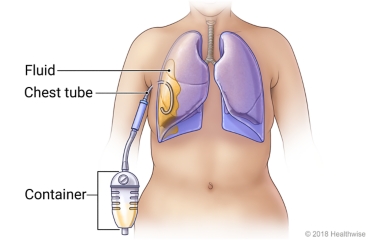
Overview
A chest tube is a hollow plastic tube. Your doctor put the tube into the space around your lungs to help remove air that shouldn't be there. It can also help drain fluid or blood.
You may need the drain because of a punctured or collapsed lung (pneumothorax) or because of a surgery you had. A drain can also help remove pus from a serious chest infection, such as pneumonia.
The tube will stay in your chest until all or most of the air, fluid, or blood drains out. This may take a few days. Your doctor may attach the tube to a device that can help the space around your lungs drain better.
The tube may have a one-way valve that lets air and fluid out, but not in. It may be called a flutter or Heimlich valve, or it may be another type of valve. Your doctor or nurse will show you how to use the valve.
If you are at home, you will need to care for the area around the chest tube and empty the container that it drains into.
Follow-up care is a key part of your treatment and safety. Be sure to make and go to all appointments, and call your doctor if you are having problems. It's also a good idea to know your test results and keep a list of the medicines you take.
How can you care for yourself at home?
- Follow your doctor's instructions on when and how to change the bandage.
- Keep the area where the chest tube comes out of your body clean and dry. If your doctor tells you to, wash the area with soap and water. Allow it to dry before covering it with a dry, clean bandage.
- If your tube drains into a container, empty the container or drainage bag before it gets full.
- Learn how to empty the drainage container for your chest tube. You may be able to dump the container into the toilet. Or you may need to use a clean syringe to pull the fluid out. Your doctor or nurse will show you how to empty the container.
- If your valve is covered with gauze, change the covering once a day or whenever it gets wet.
- Do not take a bath or swim while you have a chest tube. If you shower, keep the area dry. You might try using a waterproof dressing.
- Keep a drainage record sheet so that your doctor can see how much fluid is coming from the tube. Your doctor or nurse will give you a record sheet. Or you can just write down the date, time, amount, and color of the drainage. Save the record sheet to show to your doctor.
When should you call for help?
Call 911 anytime you think you may need emergency care. For example, call if:
- You passed out (lost consciousness).
- You have severe chest pain, or chest pain is quickly getting worse.
- You have severe trouble breathing.
- You have chest pain, are short of breath, or cough up blood.
Call your doctor now or seek immediate medical care if:
- You have trouble breathing.
- Your shortness of breath is getting worse.
- Bright red blood soaks through the bandage over your incision.
- The chest tube comes out or is bent or blocked.
- You have symptoms of infection where the tube was put in, such as:
- Increased pain, swelling, warmth, or redness.
- Red streaks leading from the area.
- Pus draining from the area.
- A fever.
Watch closely for any changes in your health, and be sure to contact your doctor if:
- You do not get better as expected.
Current as of: September 29, 2025
Author: Ignite Healthwise, LLC Staff
Clinical Review Board
All Ignite Healthwise, LLC education is reviewed by a team that includes physicians, nurses, advanced practitioners, registered dieticians, and other healthcare professionals.

